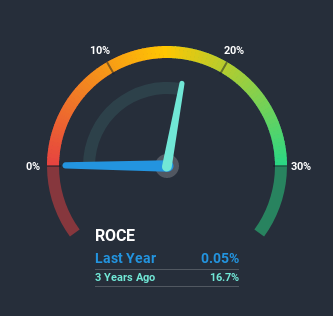What Do The Returns On Capital At Mawana Sugars (NSE:MAWANASUG) Tell Us?

If you're not sure where to start when looking for the next multi-bagger, there are a few key trends you should keep an eye out for. In a perfect world, we'd like to see a company investing more capital into its business and ideally the returns earned from that capital are also increasing. If you see this, it typically means it's a company with a great business model and plenty of profitable reinvestment opportunities. In light of that, when we looked at Mawana Sugars (NSE:MAWANASUG) and its ROCE trend, we weren't exactly thrilled.
Understanding Return On Capital Employed (ROCE)
If you haven't worked with ROCE before, it measures the 'return' (pre-tax profit) a company generates from capital employed in its business. Analysts use this formula to calculate it for Mawana Sugars:
Return on Capital Employed = Earnings Before Interest and Tax (EBIT) ÷ (Total Assets - Current Liabilities)
0.00054 = ₹2.4m ÷ (₹11b - ₹6.5b) (Based on the trailing twelve months to September 2020).
So, Mawana Sugars has an ROCE of 0.05%. In absolute terms, that's a low return and it also under-performs the Food industry average of 12%.
See our latest analysis for Mawana Sugars

While the past is not representative of the future, it can be helpful to know how a company has performed historically, which is why we have this chart above. If you'd like to look at how Mawana Sugars has performed in the past in other metrics, you can view this free graph of past earnings, revenue and cash flow.
What Can We Tell From Mawana Sugars' ROCE Trend?
When we looked at the ROCE trend at Mawana Sugars, we didn't gain much confidence. To be more specific, ROCE has fallen from 46% over the last four years. Although, given both revenue and the amount of assets employed in the business have increased, it could suggest the company is investing in growth, and the extra capital has led to a short-term reduction in ROCE. And if the increased capital generates additional returns, the business, and thus shareholders, will benefit in the long run.
On a related note, Mawana Sugars has decreased its current liabilities to 60% of total assets. That could partly explain why the ROCE has dropped. What's more, this can reduce some aspects of risk to the business because now the company's suppliers or short-term creditors are funding less of its operations. Since the business is basically funding more of its operations with it's own money, you could argue this has made the business less efficient at generating ROCE. Either way, they're still at a pretty high level, so we'd like to see them fall further if possible.What We Can Learn From Mawana Sugars' ROCE
Even though returns on capital have fallen in the short term, we find it promising that revenue and capital employed have both increased for Mawana Sugars. In light of this, the stock has only gained 38% over the last five years. Therefore we'd recommend looking further into this stock to confirm if it has the makings of a good investment.
Mawana Sugars does come with some risks though, we found 4 warning signs in our investment analysis, and 2 of those are potentially serious...
While Mawana Sugars isn't earning the highest return, check out this free list of companies that are earning high returns on equity with solid balance sheets.
If you’re looking to trade Mawana Sugars, open an account with the lowest-cost* platform trusted by professionals, Interactive Brokers. Their clients from over 200 countries and territories trade stocks, options, futures, forex, bonds and funds worldwide from a single integrated account. Promoted
New: Manage All Your Stock Portfolios in One Place
We've created the ultimate portfolio companion for stock investors, and it's free.
• Connect an unlimited number of Portfolios and see your total in one currency
• Be alerted to new Warning Signs or Risks via email or mobile
• Track the Fair Value of your stocks
This article by Simply Wall St is general in nature. It does not constitute a recommendation to buy or sell any stock, and does not take account of your objectives, or your financial situation. We aim to bring you long-term focused analysis driven by fundamental data. Note that our analysis may not factor in the latest price-sensitive company announcements or qualitative material. Simply Wall St has no position in any stocks mentioned.
*Interactive Brokers Rated Lowest Cost Broker by StockBrokers.com Annual Online Review 2020
Have feedback on this article? Concerned about the content? Get in touch with us directly. Alternatively, email editorial-team (at) simplywallst.com.
About NSEI:MAWANASUG
Mawana Sugars
Manufactures and sells sugar products in India and internationally.
Proven track record with adequate balance sheet and pays a dividend.

